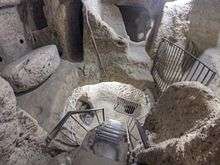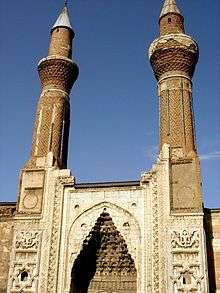Rûm
Rûm (Arabic pronunciation: [ˈruːmˤ]; singular Rûmi), also transliterated as Roum (in Arabic الرُّومُ ar-Rūm; in Persian and Ottoman Turkish روم Rûm; in Turkish: Rum), is a derivative of the term Ῥωμαῖοι (Rhomaioi). The latter was an endonym of the (pre-Islamic) inhabitants of Turkey, the Middle East, and the Balkans, dating to when those regions were parts of the Byzantine (Eastern Roman) Empire.
The term Rûm is now used to describe:
- remaining pre-Islamic ethnocultural christian minorities living in the Near East and their descendants, notably the Antiochian Greek Christians who are members of the Greek Orthodox Church of Antioch and the Melkite Greek Catholic Church of Syria, Lebanon, Jordan, Israel, occupied Palestine, and the Hatay Province in Southern Turkey whose liturgy is still based on Koine Greek.
- Orthodox christian citizens of Turkey originating in the pre-Islamic (pre-Turkic invasion) native peoples of Turkey, including Pontic Greeks from the Black Sea mountains, Cappadocians from Turkey's central plateau, and Hayhurum (Orthodox christian Armenians) from eastern Turkey. However, use of the term in Turkey is rapidly disappearing, apart from small remaining communities in Istanbul, due to genocides and expulsions of these indigenous groups throughout the 20th century, in particular the genocide of the minorities of Turkey in the 1920s and the subsequent persecutions of the 1940s and 1950s.
- geographical areas such as Anatolia and the Balkans that were historically regions within the Eastern Roman (Byzantine) Empire, or of the Seljuk Sultanate of Rûm, which ruled over conquered Byzantines (Rûm) in central Asia Minor from 1077 to 1307.

Origins
Rûm is found in the pre-Islamic Namara inscription[1] and later in the Quran (7th century), where it refers to a contemporary ruler (Heraclius) of the Byzantine (Eastern Roman) Empire, the Western Roman Empire having fallen two centuries earlier (5th century).[2]

The Qur'an includes the Surat Ar-Rum (the sura dealing with "the Romans", sometimes translated as "The Byzantines"). These people, referred to as Byzantines in modern Western scholarship, were inhabitants of the Eastern Roman (Byzantine) Empire and called themselves Ρωμιοί or Ῥωμαῖοι Rhomaioi (Romans) in their own language. (The term "Byzantine" is a modern designation to describe the Eastern Roman Empire, particularly after the major political restructuring of the seventh and eighth century.) The city of Rome was known in classical Arabic instead as Rūmiyah رومية (in modern Arabic as Rūmā روما), and Ancient Romans were called instead "Rūm" or sometimes "Latin'yun" (Latins). The Arabs called Ancient Greece by the name "Yūnān" (Ionia) and ancient Greeks "Yūnānīm" (similar to Hebrew "Yavan" [יוון] for the country and "Yevanim" [יוונים] for the people).
The Byzantine state shrank from encompassing the eastern Mediterranean in 395 AD to consisting only of what is now modern Turkey and the Balkans in 700 AD; it finally fell in 1453 AD to Turkish invaders. The Arabs, therefore, called these pre-Islamic peoples of Turkey, the Balkans, and the Middle East "Rûm", and called their territory "the land of the Rûm", generally referring to what is now Turkey and the Balkans, and called the Mediterranean "the Sea of the Rûm".
After the fall of the Byzantine state in the 15th century, the Ottoman Turkish sultan Mehmed II declared himself Kayser-i Rum, literally "Caesar of the Romans". In the Ottoman Millet system, the conquered Orthodox christian natives (i.e. the former Byzantine peoples) were placed into the "Rum Millet" (Millet-i Rum). In modern Turkey, Rum is still used to denote the Orthodox christian minority population of Turkey and other pre-conquest remnant institutions, cf. Rum Ortodoks Patrikhanesi, the Turkish designation of the Ecumenical Patriarchate of Constantinople in Istanbul.
Rûm in geography
Because Muslim contact with the Byzantine Empire most often took place in Asia Minor, which was the heartland of the Byzantine state from the seventh century onward, the term Rûm became fixed there geographically. The term remained even after the conquest of central Asia Minor by the Seljuk Turks, so their territory was called the land of the Seljuks of Rûm or the Sultanate of Rûm.
Rûm as a name
Al-Rūmī is a nisbah designating people originating in the Byzantine Roman Empire or lands that formerly belonged to Byzantine Roman Empire, especially Anatolia. Historical people so designated include the following:
- Suhayb ar-Rumi, a companion of Muhammad
- Rumi a moniker for Mawlānā Jalāl-ad-Dīn Muhammad Balkhī, the 13th-century Persian poet who lived most of his life amongst the conquered Rûm of Konya (Byzantine Greek: Ἰκόνιον) in the Sultanate of Rûm
- Qāḍī Zāda al-Rūmī, 14th-century mathematician
- Tadj ol-Molouk Ayrumlu, Former Queen of Iran
The Greek surname Roumeliotis stems from the word Rûm borrowed by Ottomans.
Other uses
During the 16th century, the Portuguese used "rume" and "rumes" (plural) as a generic term to refer to the Mamluk-Ottoman forces they faced then in the Indian Ocean.[3]
The term "Urums", also derived from the same origin, is still used in contemporary ethnography to denote Turkic-speaking Greek populations. "Rumeika" is a Greek dialect identified mainly with the Ottoman Greeks.
Chinese, during the Ming dynasty, referred to the Ottomans as Lumi (魯迷), derived from Rum or Rumi. The Chinese also referred to Rum as Wulumu 務魯木 during the Qing dynasty. The modern Mandarin Chinese name for the city of Rome is Luoma (羅馬).
Among the Muslim aristocracy of South Asia, the fez is known as the Rumi Topi (which means "hat of Rome or Byzantium").[4]
In the Sassanian period (pre-Islamic Persia) the word Hrōmāy-īg (Middle Persian) meant "Roman" or "Byzantine", which was derived from the Byzantine Greek word Rhomaioi.
See also
- Rum Millet
- Antiochian Greek Christians
- Hayhurum, Greek Orthodox Armenians of Turkey
- Rûm Province, Ottoman Empire
- Rumelia, from Turkish Rum eli meaning 'country of the Romans'
- Erzurum, from the Turkish pronunciation of Arabic أرض روم arḍ Rūm or أرض الروم arḍ ar-Rūm, 'Land of the Romans'
- Edirne Ciğeri, a Turkish meat dish also referred to as "Rumeli Ciğeri"
- Rumi calendar, a calendar based on the Julian Calendar, used by the Ottoman Empire after Tanzimat
- Mawlānā, great Persian poet who is sometimes referred to as Rumi
- Rumiye-i Suğra, or Little Rûm (Rome), is the name of the region in Ottoman Empire which included Tokat, Amasya, and Sivas
- Rumçi, another term used to refer to the Greeks during the Ottoman times
- Romaniote Jews
- Byzantine Empire
- Melkite
- Roma (disambiguation)
References
- Rûm, Nadia El Cheikh, The Encyclopaedia of Islam, Vol. VIII, ed. C.E. Bosworth, E. Van Donzel, W.P. Heinrichs and G. Lecomte, (Brill, 1995), 601.
- Nadia Maria El-Cheikh, Byzantium Viewed by the Arabs, (Harvard University Press, 2004), 24.
- Ozbaran, Salih, "Ottomans as 'Rumes' in Portuguese sources in the sixteenth century", Portuguese Studies, Annual, 2001
- The "Rumi Topi" of Hyderabad, by Omair M. Farooqui
Bibliography

Further reading
- Durak, Koray (2010). "Who are the Romans? The Definition of Bilād al-Rūm (Land of the Romans) in Medieval Islamic Geographies". Journal of Intercultural Studies. 31 (3): 285–298. doi:10.1080/07256861003724557.
- Kafadar, Kemal (2007). "Introduction: A Rome of One's Own: Reflections on Cultural Geography and Identity in the Lands of Rum". Muqarnas. 24: 7–25. JSTOR 25482452.